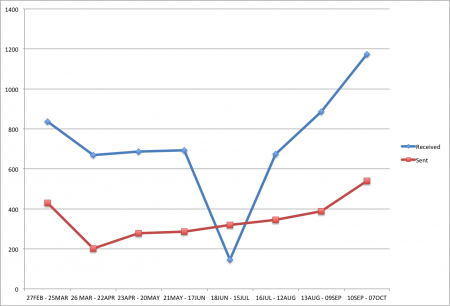To a large degree, non-academic books have been the seeds of the environmental movement. Books like Rachel Carson’s Silent Spring have fostered popular concern about environmental degradation, which in turn grew into demands that action be taken at the political level. It is therefore appropriate that Rob Nixon grounds and populates his account of the environmentalism of the poor through analysis of a selection of such texts, including Indra Sinha’s novel Animal’s People, Abdelrahman Munif’s quintet of novels Cities of Salt, the diaries and writings of Ken Saro-Wiwa, Wangari Maathai’s memoir Unbowed, Rebecca Solnit’s Savage Dreams, Arundhati Roy’s essays, James Baldwin’s “Stranger in the Village”, Michael Kelly’s Martyr’s Diary: Chronicle of a Small War, as well as the works of many other poets, essayists, novelists, and journalists. The collection of writings is diverse in geographic focus and issue-areas: including climate change, ‘megadams’, nuclear testing, tree planting, toxic contamination, fossil fuel extraction, and the environmental consequences of armed conflict.
Generally speaking, Nixon provides a compelling account of some of the ways in which exploitation of people has accompanied the exploitation of natural resources, particularly in the global south. Nixon effectively calls attention to the problem of “slow violence”, which he defines as “violence that occurs gradually and out of sight, a violence of delayed destruction that is dispersed across time and space, an attritional violence that is typically not viewed as violence at all”. Examples of this slow violence include the burden of toxicity in humans from pesticides, the radioactive remnants of the Chernobyl disaster, efforts to reduce the visibility rather than the harmfulness of the Deepwater Horizon oil spill, and the slowly-accumulating harm being done by our “200-year experiment in hydrocarbon-fueled capitalism”. Nixon points out how our psychologies and political systems are effectively primed to respond to acts of sudden bodily violence – partly encouraged by a global media focused on sensationalism – but that acts of violence committed in a sufficiently slow and disparate way can evade our acknowledgment and avoid restriction and regulation. This point is akin to that made by the French politician, theorist, and economist Frédéric Bastiat in his 1850 essay “Ce qu’on voit et ce qu’on ne voit pas”, in which he points out how governments are frequently acutely concerned about short-term consequences while simultaneously behaving indifferently toward long-term ones, while also pointing out how this asymmetry can be exploited by private companies seeking to enrich themselves in ways that cause slow or indirect harm to the general public. While Nixon’s main point is not new, he illustrates it richly with contemporary examples. By incorporating such a variety of environmental topics, Nixon effectively demonstrates the versatility and broad applicability of the concept of slow violence: a phenomenon which can make itself manifest anywhere in which the serious environmental impacts from an activity are concealed and dispersed. While Slow Violence makes convincing claims about the ongoing and perpetually-recreated violence arising from environmental degradation, it sometimes includes claims that are insufficiently corroborated with sources or evidence. While the impact of books like Carson’s largely derives from their accessibility, at times Nixon’s prose reads like a parody of post-modernist writing. For instance, when he discusses “the administration of difference between those who gain official recognition as sufferers and those dismissed as non-sufferers because their narratives of injury are deemed to fail the prevailing politico-scientific logic of causation”.
For the most part, Nixon’s environmental philosophy goes further than those of the academic mainstream. Rather than accepting a liberal account in which most economic activity is generally beneficial to human interests, but where unmitigated externalities cause harm, Nixon’s perspective on the degree of harm being done by human beings to the natural world and to one another by virtue of global capitalism is of another order. He questions the justness and desirability of the entire global economic structure and sometimes seems to suggest a preference for a pre-industrial style of global economic organization. Insofar as Nixon’s analysis focuses on the exploitative structure of the economic relations of the global north and south, it mirrors elements of Immanuel Wallerstein’s world-systems theory as well as elements of neo-Marxist theories of international relations. While he does not necessarily employ the terminology of these theories, Nixon does highlight the dynamics that exist between core and peripheral countries and the relations of domination that can exist between the two, for instance, when he engages with Saro-Wiwa’s “campaign against a center-periphery paradigm”.
Insofar as Nixon is optimistic about the potential of writers to change public conceptions about behaviours that impact the environment, he displays a constructivist optimism about the possibility for learning and for norms to evolve into less harmful forms. In the epilogue, as well as in an interview on the Social Text Blog, Nixon cites South African writer and activist Nadine Gordimer as one of the inspirations for his thinking on the world-altering power of writing. In a lecture on writers and responsibility, Gordimer argues that: “Writers who accept a professional responsibility in the transformation of society are always seeking ways of doing so that their societies could not ever imagine, let alone demand.” This perspective accords well with the constructivist focus on the importance of ideas in explaining change in world politics.
Another way of situating Nixon’s work is as part of the ‘social green’ school of environmentalist thought delineated by Jennifer Clapp and Peter Dauvergne. According to Clapp, adherents of this school “see social and environmental issues as inseparably linked”, and have a focus on “[i]nequality and domination, exacerbated by economic globalization”. Nixon also shares the social green belief that reactive crisis management within a neoliberal economic framework will not be sufficient to address the world’s environmental problems successfully, as well as the general social green rejection of the inherent value of pristine wilderness free of local people. Nixon criticizes “ethics-of-place environmentalism” which he describes as “misanthropic, jingoistic, xenophobic, racially blinkered, gender entitled, and amnesiac celebrations of wilderness”. In addition to directing criticism at governments and corporations, Nixon objects to groups that impose “American- and European-style conservation agendas” despite the protests of local peoples. Arguably, Slow Violence is not primarily a work of analysis. As demonstrated through Nixon’s assertion that “[a] major challenge is representational: how to devise arresting stories, images, and symbols adequate to the pervasive but elusive violence of delayed effects”, it is clear that the author wants to go beyond understanding the causes of slow violence and begin the normative project of attenuating it. Slow Violence also attempts to identify ways in which relatively alienated schools of thought can be usefully reconciled with one another – particularly in the case of “bring[ing] environmentalism into a full, productive dialogue with postcolonialism”.
While Nixon devotes considerable effort to describing the ways in which rich-world consumers impose the consequences of their choices on unconsenting others, he arguably fails to adequately examine the ways in which solving environmental problems can require coercion. Particularly in the area of climate change, Slow Violence could have devoted more attention to engaging with questions of how people can be effectively compelled to change their behaviour in response to the legitimate claims of distant victims of their choices. British activist and author George Monbiot describes how:
“[T]he campaign against climate change is an odd one. Unlike almost all the public protests which have preceded it, it is a campaign not for abundance but for austerity. It is a campaign not for more freedom but for less. Strangest of all, it is a campaign not just against other people, but also against ourselves.”
Inspiration from skilled environmental authors can play a role in developing the political will to take action, but environmental problems of the scale and severity Nixon describes seem unlikely to be solvable without the imposition of unpopular constraints on the lifestyles of those who are already wealthy and the development prospects of those who have not yet achieved that standard. Even if the technologically sophisticated “broad coalition” that Nixon alludes to in the book’s closing pages does assemble, it isn’t clear how they could drive the comfortable to give up luxuries and conveniences that they have come to expect, nor how they could convince the world’s aspirational poor to accept a future in which they may never achieve them.
Another flaw in Nixon’s analysis is the failure to consider situations in which negative environmental outcomes have been averted or reversed. Almost invariably, the accounts Nixon relates describe foreign corporations being drawn into countries in the global south in search of natural resources, then leaving behind catastrophe and ruin. Some of the claims in the text also strain credibility. For instance, Nixon states that “it was argued by some that [methane and carbon dioxide emissions from flaring in Nigerian oil fields during the 1990s] was the single greatest contributor worldwide to climate change”. Nixon cites estimated emissions of 12 million tonnes of methane and 35 million tonnes of carbon dioxide. The Intergovernmental Panel on Climate Change (IPCC) estimates global anthropogenic greenhouse gas emissions for 1990 at 39.4 billion tonnes of carbon dioxide equivalent, suggesting that the Nigerian emissions may have represented approximately 0.09% of the total in terms of CO2 and 0.76% of the total in terms of methane, using the IPCCs 100-year global warming potential for methane of 25. Nixon also claims without providing a reference that this flaring “foreshortened the life expectancy of the delta peoples”. At times, Nixon is willing to use dubious sources to support his claims, including hearsay cited in blog posts. Nixon is also uncritically accepting of the peak oil hypothesis, despite the ongoing surge in unconventional oil extraction and without much consideration for what the climatic and societal impacts of such a peak might be. The analysis of the pattern of environmental degradation presented in Slow Violence might have been further enriched through the historical examination of some of the parts of the world that have successfully transitioned from highly environmentally destructive modes of economic development to modes that are far more benign, at least in their local effects. For instance, Nixon could have considered the post-WWII history of Japan as an example of a state that moved through a period of highly toxic export-led growth, but which was subsequently able to adopt rigorous environmental standards.
In the end, while elements of Nixon’s argument and philosophy can be criticized, his basic argument is convincing and well supported by the examples he cites. One of the most perplexing features of living in a globalized world of complex interdependence is the reality that the choices made by one group of people will impact the lives of other groups distantly separated in both space and time. In such a world, “human rights are indissociable from environmental justice”. Nixon’s concerns about inequality, the unequal application of the law, and the perverse consequences of capitalism have considerable application in the contemporary world and point to phenomena that have been inadequately incorporated into political and international relations theory. Through the breadth of his examples, Nixon highlights the magnitude of the collection of environmental issues facing humanity; simultaneously, by focusing on the ways in which writers have affected both thinking and outcomes related to the environment, he sketches out a plausible program for improving policy. While Slow Violence does include small-scale flaws, it succeeds in making the large-scale point about the practical and ethical importance of making violence visible and taking action to curb it.



